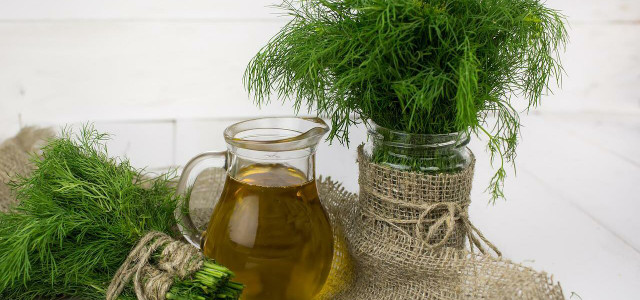Air drying fresh dill weed and seeds doesn’t take long and lets you sustainably preserve and store the herb. Here are two ways to dry dill without an oven.
Dill weed is a popular herb, essential for pickling and adding flavor to soups, sauces and other dishes. Dill is also rich in flavonoids, which have antioxidant and anti-inflammatory properties. If you have a green thumb, you can add it to your kitchen herb garden or plant it outside for easy access during warmer months. However, if you want to dry dill weed and seeds to store and keep around all year, it’s easy to learn how.
Air-Dry Dill Indoors Using the Hanging Method

(Foto: CC0 / Pixabay / PhotoMIX-Company)
Before drying dill, collect everything you’ll need.
Materials:
- Kitchen towel or salad spinner
- Scissors
- Rubber bands or string
- Container for the dry leaves and seeds
Once you’ve gathered your materials, follow the steps below.
How to air-dry dill using the hanging method:
- Rinse the dill in cool water and pat dry with a kitchen towel or dry in a salad spinner.
- Separate the sprigs into small bunches, securing each bunch with a rubber band or string. Make sure to tie them tightly, as the stems will shrink as they dry and you don’t want them to fall down.
- Hang the bundles upside-down in a dry, shaded area and allow them to dry out for 1-2 weeks. If you live in a more humid climate, the drying process can take up to 3 weeks.
- Once the bundles are dry, place them on a clean, clear surface and remove the leaves and seeds from the stems, placing them in separate bowls. If completely dry, the leaves should fall away from the stems easily.
- Crush or grind the leaves, then store the crushed leaves and seeds in separate containers placed in a cool, dark location.
Air-dried dill retains its flavor for about a year when stored properly. Dried dill can be used similarly to the fresh plant. Use it to make delicious plant-based dishes like vegan spanakopita and vegan lox or as a savory flavor booster on homemade popcorn.
Note: Dry dill leaves lose some strength when dried, so you may need to add a little more to get the same flavor as fresh. Dried seeds, however, take on an even stronger taste.
Dry Dill Indoors Using a Baker’s Rack
You can also dry dill on a baker’s rack. This method works best if you live in a warm, dry climate or the forecast calls for several (3-4) hot and sunny days. To begin, collect your materials, then follow the steps below.
Materials:
- Baker’s rack or similar shallow-rimmed tray (use separate racks for drying leaves and seeds)
- Kitchen towel or salad spinner
- Scissors
- Cheesecloth
How to air-dry dill using a baker’s rack:
- Rinse the dill in cool water and pat dry with a kitchen towel or dry in a salad spinner.
- Line your rack with cheesecloth.
- Spread the leaves or seeds in a single even layer across the rack. A thinner layer encourages air circulation, speeds up the drying process and reduces the risk of mold.
- Place the rack in a warm, dry location, preferably just out of direct sunlight.
- Turn the leaves or stir the seeds every day or so, ensuring they are evenly exposed to the warm air.
- Once completely dry, the leaves should easily fall away from the stems. At this point, crush or grind the leaves, then store the crushed leaves and seeds in separate containers placed in a cool, dark location.
Note: By choosing not to dry your dill for several hours in the oven, you save energy and get better-quality, more aromatic dried herbs.
Read on:
- How to Dry Chives: Tips for Harvesting, Drying & Storing
- How to Dry Herbs: 4 Easy Methods You Should Know
- How to Grow a Herb Garden on Your Windowsill
Important Information regarding Health-related Topics.
** Links to retailers marked with ** or underlined orange are partially partner links: If you buy here, you actively support Utopia.org, because we will receive a small part of the sales proceeds. More info.Do you like this post?






